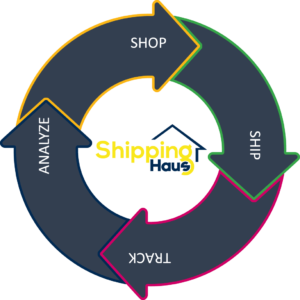Most shipping software for small/medium-sized businesses do not offer PO management on inbound orders from suppliers and vendors, however, Shipping Haus’s shipping technology and solutions does!
In previous posts, we looked at how our shipping solution enables shippers to use their Shipping Haus partner rates on inbound and drop shipments and make marning on those shipments. We showed how this lets them bypass markups and has the added benefit of offering unprecedented visibility on such shipments.
Today, we will look at best practices for Inbound PO Management.
Inbound Shipping PO Management

Traditional shipping solutions only offer outbound sales order management. Our solution allows two-way interaction between our customers and their suppliers through a centralized portal. This gives them better control of consolidating and troubleshooting orders.
There are a few options with the supplier portal.
- Customers can supply their vendors logins to their TMS so they can generate invoices and fulfillment information.
- For customers with huge vendor lists where supplying logins for everyone would prove difficult, we backfill data automatically on inbound orders through supplier account numbers.
- This is unique for a TMS as we integrate the order management to pull purchase order/sales data.
Maybe now would be a good time to do a rate comparison!
Inbound Shipping Hiccups
Several costly issues can occur during the inbound shipping process.
Lack of visibility:
This leads to a lack of control. A business cannot adequately stay on top of inventory when it is not aware of what inbound goods are in transit, where they are at, and when they’ll arrive. Warehouses cannot prepare properly to accept goods without visibility, which can lead to potential bottlenecks.
Lack of visibility does not allow shippers to provide adequate customer service. There is no way a shipper can troubleshoot issues or pre-notify customers of a late delivery when they do not have the insight.
No set standards of compliance:
Shippers are subject to vendor/supplier selection of shipping routes, carriers, and shipping rates and accessorial fees. This leaves shippers vulnerable to any costs and timeframes the provider selects.
No accountability on set standards:
Shippers are left with no mechanism for monitoring and reporting. They miss out on data, which can inform future procurement decisions.
Inbound Shipping Optimization Through Shipping Haus technology
Using shipping software, or a TMS/Transportation Management System, that integrates warehouse and ordering systems is essential in this day and age of tight competition, ever-increasing eCommerce, and demanding delivery times.
A TMS solution that integrates with inbound shipping can offer:
- Real-time visibility into all inbound shipments – stay on top of inventory quantities, troubleshoot delays, and prepare for any influx
- Insight into where you can improve procurement practices
- Business intelligence into how well your standards are being adhered to
- Ready access to shipping costs – cost increases are not always communicated until after the shipment is sent
- Greater control over routing changes once shipments are en route
Shipping Haus’s Inbound Shipping TMS tools include:
- PO Management:
- Easy access portals for processing
- PO data imported from ERPs into our TMS Vendor and Supplier Portal
- In-transit Reports for Inbound Shipments
- Stay on top of inventory
- The ability to troubleshoot
- Preferred Partner Rates Program
- Shippers provide suppliers with an account number featuring Shipping Haus’s bulk negotiated rates, bypassing markup charges and saving on overall shipping costs
If you would like advice on how to improve your inbound shipments, please reach out to us below. We are happy to share what our TMS features can accomplish for you!
Contact us now via this contact form, or feel free to give us a call at 833.SHP.HAUS


Leave A Comment